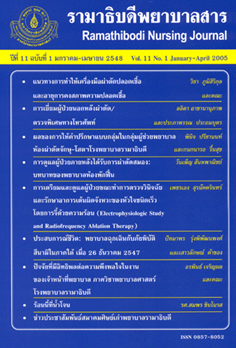ปัจจัยทำนายการปรับตัวของผู้ดูแลเด็กโรคลมชัก
Main Article Content
Abstract
บทคัดย่อ
การวิจัยบรรยายเชิงทำนายครั้งนี้มีวัตถุประสงค์เพื่อศึกษาความสามารถของการรับรู้ความรุนแรงของการชัก การสนับสนุนทางสังคม จำนวนปีที่ได้รับการศึกษา และรายได้ครอบครัว ในการทำนายการปรับตัวของผู้ดูแลเด็กโรคลมชัก โดยใช้ทฤษฎีการปรับตัวของรอยเป็นกรอบแนวคิด กลุ่มตัวอย่างเป็นผู้ดูแลที่พาผู้ป่วยเด็กโรคลมชักมารับการตรวจรักษาที่คลินิก โรคระบบประสาทในเด็ก แผนกผู้ป่วยนอก โรงพยาบาลราชบุรี จำนวน 94 ราย คัดเลือกกลุ่มตัวอย่างแบบเฉพาะเจาะจง เครื่องมือที่ใช้ในการเก็บรวบรวมข้อมูล ได้แก่ แบบบันทึกข้อมูลส่วน บุคคล แบบวัดการปรับตัวของผู้ดูแล และแบบสอบถามแรงสนับสนุนทางสังคม วิเคราะห์ข้อมูล โดยใช้สถิติพรรณนา สัมประสิทธ์สหสัมพันธ์ของเพียร์สัน สหสัมพันธ์แบบอันดับของสเปียร์แมน และการวิเคราะห์ความถดถอยเชิงพหุคูณ ผลการศึกษาพบว่า การรับรู้ความรุนแรงของการชักมีความสัมพันธ์ทางลบกับการปรับตัว ส่วนการสนับสนุนทางสังคมมีความสัมพันธ์ทางบวกกับการปรับตัวอย่างมีนัยสำคัญทางสถิติ แต่จำนวนปีที่ได้รับการศึกษา และรายได้ครอบครัวไม่มี ความสัมพันธ์กับการปรับตัวของผู้ดูแลเด็กโรคลมชักอย่างมีนัยสำคัญทางสถิติ ตัวแปรที่ศึกษา ทั้งหมด (การรับรู้ความรุนแรงของการชัก การสนับสนุนทางสังคม จำนวนปีที่ได้รับการศึกษา และรายได้ครอบครัว) สามารถร่วมกันอธิบายความแปรปรวนการปรับตัวของผู้ดูแลเด็กโรคลมชัก ได้ร้อยละ 24.5 โดยการรับรู้ความรุนแรงของการชัก และการสนับสนุนทางสังคม เป็นปัจจัยทำนายการปรับตัวของผู้ดูแลเด็กโรคลมชักได้อย่างมีนัยสำคัญทางสถิติ จากผลการศึกษามีข้อ เสนอแนะว่าพยาบาลควรประเมินการรับรู้ความรุนแรงของการชักและการสนับสนุนทางสังคมของผู้ดูแลเด็กโรคลมชักและหาแนวทางในการเพิ่มการสนับสนุนทางสังคมเพื่อส่งเสริมปรับตัว ของผู้ดูแลเด็กโรคลมชัก
คำสำคัญ: การปรับตัว ปัจจัยทำนาย ผู้ดูแล โรคลมชัก
Abstract
This descriptive study aimed to investigate the ability of study variables (perceived seizure severity, social support, years of education, and family income) to predict adaptation among caregivers of children with epilepsy. Roy's adaptation model was used as the conceptual framework. Purposive sampling was used to recruit a sample of 94 caregivers of children with epilepsy at the Pediatric Neurological Clinic, Outpatient Department, Ratchaburi Hospital. Instruments for data collection consisted of the Demographic Data Record Form, the Caregiver’s Adaptation Questionnaire, and the Social Support Questionnaire. Data were analyzed using descriptive statistics, Pearson’s correlation coefficient, Spearman's rank correlation, and multiple regressions with the Enter method. The results revealed that perceived seizure severity was negatively correlated with adaptation; social support was positively correlated with adaptation. However, years of education and family income were not significantly correlated with adaptation. All study variables (perceived seizure severity, social support, years of education, and family income) together explained 24.5 % of variance in adaptation among caregivers of children with epilepsy. However, only perceived seizure severity and social support were the significant predictors of adaptation. The study findings suggest that nurses should assess perceived seizure severity and social support among caregivers of children with epilepsy and find strategies to enhance social support in order to promote adaptation.
Keywords: Adaptation, Predictive factors, Caregiver, Epilepsy
Article Details
บทความ ข้อมูล เนื้อหา รูปภาพ ฯลฯ ที่ได้รับการตีพิมพ์ในรามาธิบดีพยาบาลสาร ถือเป็นลิขสิทธิ์ของวารสาร หากบุคคลหรือหน่วยงานใดต้องการนำทั้งหมดหรือส่วนหนึ่งส่วนใดไปเผยแพร่หรือเพื่อกระทำการใด ใด จะต้องได้รับอนุญาตเป็นลายลักษณ์อักษรจากรามาธิบดีพยาบาลสารก่อนเท่านั้น


